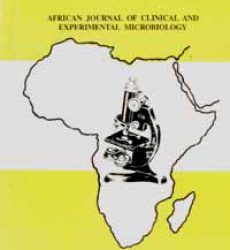Abstract
Amoebiasis is an infection caused by water borne protozoan parasite Entamoeba histolytica. In Uganda where sanitation infrastructure and health education was not adequate, amoebiasis was thought to be still an important health problem. However there was little or no data on prevalence of this very important protozoan infection. In addition, microscopy remained the main method for the diagnosis of amoebiasis but could not differentiate between Entamoeba dispar/moshkovskii and Entamoeba histolytica infections. This made determination of true prevalence of Entamoeba histolytica infections difficult. It was against this background that this study was designed to carry out species specific diagnosis of Entamoeba histolytica and Entamoeba dispar/moshkovskii in Uganda where these species had been reported to be endemic. This study used microscopy and polymerase chain reaction amplification of Serine-rich Entamoeba histolytica (SREHP) gene. It was shown that 36.7% (n=22) of the samples initially diagnosed as positive by microscopy were positive by PCR. The true prevalence of E. histolytica and E.dispar/ moshkovskii was found to be 7.31% and 12.6% respectively. It was concluded that Entamoeba infection in Soroti, Eastern Uganda is more frequently due to E. dispar /moshkovskii (13.3%) the non-pathogenic forms than to E. histolytica, the pathogen (7.31%).
Key words: Entamoeba histolytica, Microscopy, Polymerase chain reaction, Prevalence.
Download full journal in PDF below

